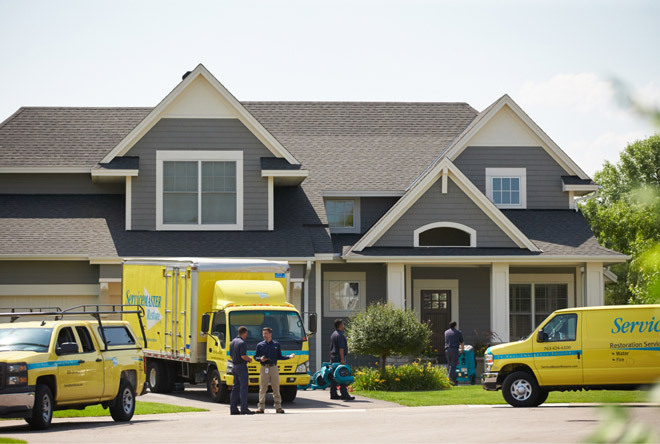Mold Remediation Process

At ServiceMaster Restore, our trained specialists utilize a comprehensive mold remediation process to ensure that your mold problem is resolved.
1. Inspect and Assess the Mold Damage
The first step in our process is to inspect the area of concern, identify the water sources feeding the mold, and assess the damage. Our technicians will not only check for visible signs of mold, but employ various technologies for detecting hidden mold and water sources. We can report this to your insurance company and develop a plan to clean the area, eliminate the the source of what is causing the mold, and implement processes to to prevent future mold growth.
2. Contain the Mold
Armed with a plan, we turn our attention to isolating and containing the mold. In this process, we use advanced techniques involving physical barriers and negative air pressure to prevent mold spores from spreading during the cleanup process. During this process, all fans and any heating, venting and cooling systems are turned off to prevent the further spread of the mold.
3. Filter the Air
With the mold contained, our team can turn its attention to capturing, filtering and scrubbing the microscopic mod spores from the air using specialized filtration equipment including “air scrubbers” and HEPA vacuums.
4. Remove the Mold
Using antifungal and antimicrobial treatments, our certified mold remediation technicians eliminate mold colonies and then remove and dispose of any mold-infested porous materials like drywall and carpeting.
5. Clean, Sanitize and Deodorize the Space
Once the mold is removed form the space, our technicians will clean, sanitize and deodorize belongings like furniture, curtains, clothing, decorations and other restorable items affected by mold.
6. Restore the Property
In cases where the mold damage is severe, our construction team may need to replace drywall, subfloors and other building materials as well paint, install new carpet or perform other minor repairs to restore the space to pre-loss condition.
how to prevent Mold Growth
The key to inhibiting mold from growing in your home or business is to understand that where there is moisture, there is often mold. Molds thrive in moist environments, but also need an organic food source like cellulose, which is typically found in building materials such as wood and drywall. Listed below are some tips for limiting moisture buildup and preventing mold-inducing conditions.
- Be proactive and keep indoor humidity low, ideally between 30 and 50 percent relative humidity.
- Measure humidity levels with a humidity meter, an inexpensive device that will let you easily check the humidity in your home or office.
- Condensation can be a sign of high humidity. If you see moisture on windows, walls or pipes, dry the wet surface immediately.
- Ventilate showers and cooking areas.
- Use a dehumidifier and air conditioner during especially humid months.
In the event of a water leak or spill, time is of the essence. Dry materials that are wet or damp within 24 to 48 hours. It is unlikely that mold will grow if you do this. If materials or areas remain wet, it is inevitable that mold will start to grow.
In larger damage situations like flooding or broken pipes, mold may never become visible, since it can grow in the walls and under the floor. Left untouched, this can cause serious structural damage. Bleach will not kill this mold and stop its growth.


